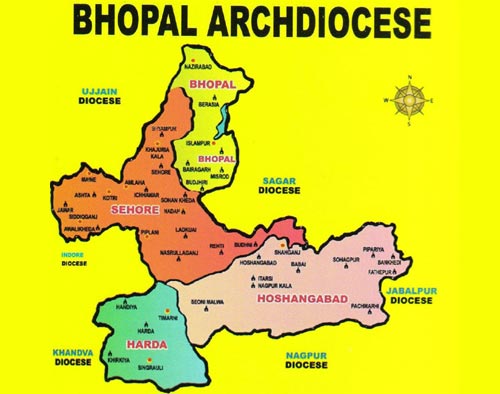Short history of bhopal Archdiocese
Welcome to the city of lakes
Introduction
Bhopal is known as the “city of lakes”; its name is a derivation of Bhoj Tal (“Bhoj’s Lake”), a lake constructed by Bhoj, a Hindu raja, in the 11th century. Today that lake is the Upper Bhopal Lake (Bada Talab), which is connected to the Lower Bhopal Lake (Chhota Talab) by an aqueduct. The lakes supply drinking water and are used for recreation. Around the lakes are several palaces and a fort dating from about 1728. Bhopal has several mosques, including the 19th-century Taj-ul-Masjid, the largest mosque in India. A three-day religious pilgrimage is held at the mosque annually, which attracts Muslim pilgrims from all parts of India. Other significant attractions in and around Bhopal include Fatehgarh Fort; Lakshminarayan Temple; Bharat Bhawan, a multipurpose arts centre; the Museum of Man, an open-air exhibit of replicas of different Indian tribal dwellings; and Van Vihar National Park, a zoological park.
Bhopal was constituted a municipality in 1903. At India’s independence in 1947, Bhopal remained a separate province until 1949, when it acceded to India. In 1952 the nawab’s absolute rule was abolished, and a chief commissioner’s state was established. It merged with Madhya Pradesh in 1956, and Bhopal replaced Nagpur as the state capital.
In December 1984 Bhopal was the site of the worst industrial accident in history, when about 45 tons of the dangerous gas methyl isocyanate escaped from an insecticide plant that was owned by the Indian subsidiary of the American firm Union Carbide Corporation. killing thousands of people.

History
The history of the Catholic Church in Bhopal goes back to 1785, when Salvador Bourbon, a descendant of the French Royal Catholic Family of Bourbons, came to Bhopal to work for the reigning Begum Mamola at Bhopal .In 1829 Bhopal was officially a part of Agra Vicariate. It was Bishop Hartmann OFM,Cap, who is in a very real sense the founder of the Church of Bhopal In 1873 he acquired a plot of land from the Muslim ruler of Bhopal and built the first little church, which, in 1964 became the Cathedral of the newly erected Archdiocese of Bhopal. In 1886 the Archdiocese of Allahabad was formed and Bhopal was then attached to this new Archdiocese . On March 11, 1935. the Mission Territory of Indore was elevated to Prefecture to Indore. In 1958 the capital of the state of Madhya Pradesh was shifted from Nagpur to Bhopal and this necessitated the creation of the new Archdiocese of Bhopal. Bishop Eugene D'Souza was transferred from Nagpur to Bhopal to be its First Archbishop. Archbishop Eugene laid down his office and handle over to Bishop Pascal Topno, SJ, of Ambikapur, who was promoted as Archbishop of Bhopal on May 20, 1994. On June 15, 2007 Pope Benedict XVI appointed Dr Leo Cornelio as the new Archbishop of Bhopal Suffragan Archdiocese of the archdiocese are Gwalior, Indore, Jabalpur, Jhabua, Khandwa, Sagar (Syro-Malabarese), Satna (Syro-Malabarese), Ujjain (Syro-Malabarese).
